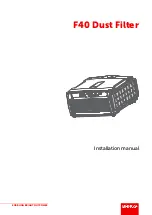
3
Chlorine Reduction:
300,000 gallons or up to 3 years
@ 12 gpm
Scale Prevention:
Up to 3 years
Feed Water Chemistry
Requirements
NOTICE
CAUTION
!
• Do not let the system freeze. Damage to the system
may result.
• System must be shipped and operated in an upright and
vertical position. It must remain in an upright and vertical
position during operation.
• Place the system on a smooth, level surface. Because
the inner OneFlow
®
tank operates in an UP-Flow, fluidized
bed mode, having a level surface is more important than
with a softener or media filter.
• A bypass valve should be installed on every system to
facilitate installation and service.
• Observe all local plumbing and building codes when
installing the system.
• All new copper pipe and fittings used in the installation
of this system should be allowed to self passivate, under
normal operation and water flow, for a period of 4 weeks
minimum before placing the unit into service.
• If making a soldered copper installation, do all sweat
soldering before connecting pipes to the bypass valve.
Torch heat will damage plastic parts.
• When turning threaded pipe fittings onto plastic fittings, use
care not to cross-thread.
• Use PTFE tape on all external pipe threads. Do not use pipe
joint compound.
• Support inlet and outlet plumbing in some manner (use pipe
hangers) to keep the weight off of the bypass fittings.
• Do not use on water that is microbiologically unsafe or of
unknown quality.
Notes to the Installer
The E-Treat system differs from a conventional softener or
media filter in a number of key respects.
• Must be installed in VERTICAL POSITION.
• Please see the notes about “Feed Water Chemistry
Requirements” section on page 3.
• Please see the note about “Using E-Treat Systems with
Other Water Treatment Equipment” on page 2.
• This system is designed for residential applications only.
Note: Plumbing tape and general plumbing tools required.
NOTICE
pH
6.5-8.5
Hardness (maximum)
30 grains (513 ppm CaCO3)*
Water Pressure
20 psi to 125 psi (1.37 bar to 8.61 bar)
Temperature
40°F to 100°F (5°C to 38°C)
Free Chlorine
<2 ppm
Iron (maximum)
0.3 ppm**
Manganese (maximum)
0.05 ppm**
Copper
1.3 ppm***
Oil & H2S
Must be Removed Prior to E-Treat System
Total Phosphates
< 3.0 ppm
Silica (maximum)
20 ppm
†
TDS
1500 mg/l
††
NOTICE
* Systems using OneFlow
®
technology are effective at con-
trolling lime-scale formation inside the plumbing system at
influent hardness levels up to 30 grains per gallon (513 ppm
CaCO3) of calcium carbonate. Due to variances in water
chemistry, 30 grains per gallon is a recommended hardness
maximum due to potential aesthetic issues related to soft
scale residue formation outside of the plumbing system.
Testing should be performed to determine proper application
where hardness levels exceed 30 grains per gallon.
** Just as with conventional water softening media, OneFlow
®
media needs to be protected from excess levels of certain
metals that can easily coat the active surface, reducing its
effectiveness over time. Public water supplies rarely, if ever,
present a problem, but if the water supply is from a private
well, confirm that the levels of iron (Fe) and manganese (Mn)
are less than 0.3 ppm and 0.05 ppm, respectively.
*** Pursuant to the EPA drinking water standards, the cop-
per concentration permitted is up to 1.3 ppm. Typically
originating from new copper plumbing, high levels of cop-
per can foul OneFlow
®
media. New Copper lines need to
be passivated for a minimum of 4 weeks before placing
unit into service. For applications with copper concentra-
tion greater than 1.3 ppm, please consult Watts Water
Quality Technical Service. To further minimize any problem
with excess copper, avoid applying excessive flux on the
inner surfaces of the pipe and use a low-corrosivity water
soluble flux listed under the ASTM B813 standard.
NOTICE
†
OneFlow
®
media does not reduce silica scaling. While silica
tends to have a less significant effect on scale formation than
other minerals, it can act as a binder that makes water spots
and scale residue outside the plumbing system difficult to
remove. This 20 ppm limitation is for aesthetic purposes.
††
All other contaminants must meet the requirements of the
USEPA Safe Drinking Water Act. Specific Mineral and Metal
MCL's, identified in Watts published Feed Water Chemistry
Requirements, supersedes the USEPA SDWA.
Water known to have heavy loads of dirt and debris may
require pre-filtration prior to the E-Treat System.
WARNING
!
Contaminant Treatment
Summary of Contents for E-Treat ETREATWCS
Page 12: ......






























